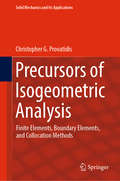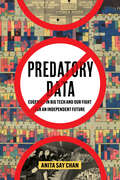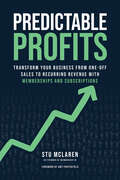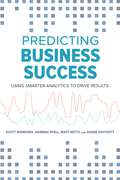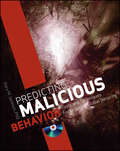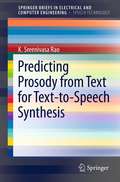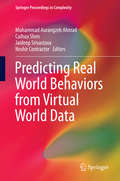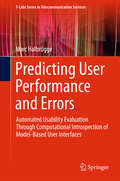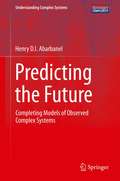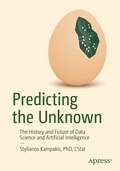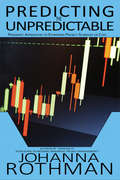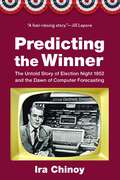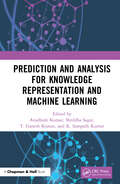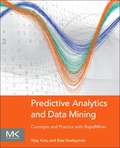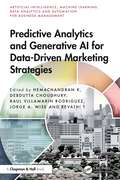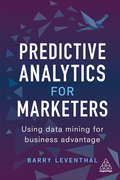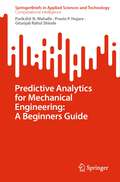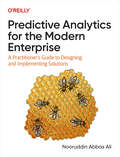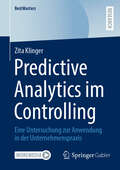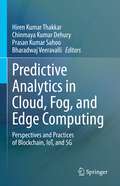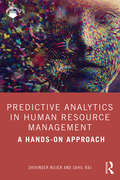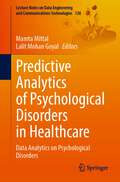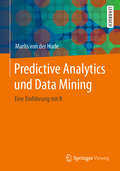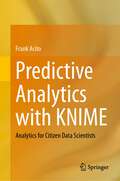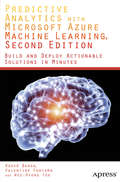- Table View
- List View
Precursors of Isogeometric Analysis: Finite Elements, Boundary Elements, and Collocation Methods (Solid Mechanics and Its Applications #256)
by Christopher G. ProvatidisThis self-contained book addresses the three most popular computational methods in CAE (finite elements, boundary elements, collocation methods) in a unified way, bridging the gap between CAD and CAE. <P><P>It includes applications to a broad spectrum of engineering (benchmark) application problems, such as elasto-statics/dynamics and potential problems (thermal, acoustics, electrostatics). It also provides a large number of test cases, with full documentation of original sources, making it a valuable resource for any student or researcher in FEA-related areas. <P><P>The book, which assumes readers have a basic knowledge of FEA, can be used as additional reading for engineering courses as well as for other interdepartmental MSc courses.
Predatory Data: Eugenics in Big Tech and Our Fight for an Independent Future
by Anita Say ChanThe first book to draw a direct line between the datafication and prediction techniques of past eugenicists and today's often violent and extractive "big data" regimes. Predatory Data illuminates the throughline between the nineteenth century's anti-immigration and eugenics movements and our sprawling systems of techno-surveillance and algorithmic discrimination. With this book, Anita Say Chan offers a historical, globally multisited analysis of the relations of dispossession, misrecognition, and segregation expanded by dominant knowledge institutions in the Age of Big Data. While technological advancement has a tendency to feel inevitable, it always has a history, including efforts to chart a path for alternative futures and the important parallel story of defiant refusal and liberatory activism. Chan explores how more than a century ago, feminist, immigrant, and other minoritized actors refused dominant institutional research norms and worked to develop alternative data practices whose methods and traditions continue to reverberate through global justice-based data initiatives today. Looking to the past to shape our future, this book charts a path for an alternative historical consciousness grounded in the pursuit of global justice. A free ebook version of this title is available through Luminos, University of California Press’s Open Access publishing program. Visit www.luminosoa.org to learn more.
Predictable Profits: Transform Your Business from One-Off Sales to Recurring Revenue with Membershipsand Subscriptions
by Stu McLarenLaunch, grow, and scale your membership businessWhat if you could stop chasing one-off sales and build a business that pays you consistently, month after month?In Predictable Profits, membership expert Stu McLaren pulls back the curtain on how to create a thriving membership business that doesn&’t just bring in revenue—but does so predictably, allowing you to focus on what truly matters.Drawing on nearly two decades of membership experience, Stu shares:Three telltale signs that you have a perfect market for a membership site How to effortlessly attract new members—even if you don&’t like to &“sell&”Why closing your doors will lead to faster and more explosive growth in your membershipA simple blueprint for creating irresistible content that keeps your members coming back for moreWhat to do in the first 30 days to triple the lifetime value of your membersPredictable Profits is packed with real-life success stories, actionable insights, and all the inspiration you need to build a membership site that does more than just generate revenue—it creates financial stability, positive impact, and ultimate freedom.Turn what you already know, love, and do into a thriving online business. This remarkable book will show you how.
Predicting Business Success: Using Smarter Analytics to Drive Results
by Matt Betts Shane Douthitt Scott Mondore Hannah SpellHR leaders know people drive business results but often struggle to prove it with data. Predicting Business Success empowers HR professionals to move beyond basic metrics and directly connect talent data to the outcomes executives care about. This practical guide provides a step-by-step approach to scaling analytics organization-wide, making talent profiles predictive and using data to inform key areas such as hiring, onboarding, surveys and training. With actionable strategies for data collection and application, it shows how to embed analytics into everyday decision-making at every level. For HR teams looking to increase influence and drive measurable business impact, this book is an essential roadmap.
Predicting Malicious Behavior
by Gary M. JacksonA groundbreaking exploration of how to identify and fight security threats at every levelThis revolutionary book combines real-world security scenarios with actual tools to predict and prevent incidents of terrorism, network hacking, individual criminal behavior, and more. Written by an expert with intelligence officer experience who invented the technology, it explores the keys to understanding the dark side of human nature, various types of security threats (current and potential), and how to construct a methodology to predict and combat malicious behavior. The companion CD demonstrates available detection and prediction systems and presents a walkthrough on how to conduct a predictive analysis that highlights proactive security measures.Guides you through the process of predicting malicious behavior, using real world examples and how malicious behavior may be prevented in the futureIllustrates ways to understand malicious intent, dissect behavior, and apply the available tools and methods for enhancing securityCovers the methodology for predicting malicious behavior, how to apply a predictive methodology, and tools for predicting the likelihood of domestic and global threats CD includes a series of walkthroughs demonstrating how to obtain a predictive analysis and how to use various available tools, including Automated Behavior AnalysisPredicting Malicious Behavior fuses the behavioral and computer sciences to enlighten anyone concerned with security and to aid professionals in keeping our world safer.
Predicting Prosody from Text for Text-to-Speech Synthesis
by K. Sreenivasa RaoPredicting Prosody from Text for Text-to-Speech Synthesis covers the specific aspects of prosody, mainly focusing on how to predict the prosodic information from linguistic text, and then how to exploit the predicted prosodic knowledge for various speech applications. Author K. Sreenivasa Rao discusses proposed methods along with state-of-the-art techniques for the acquisition and incorporation of prosodic knowledge for developing speech systems. Positional, contextual and phonological features are proposed for representing the linguistic and production constraints of the sound units present in the text. This book is intended for graduate students and researchers working in the area of speech processing.
Predicting Real World Behaviors from Virtual World Data
by Muhammad Aurangzeb Ahmad Cuihua Shen Jaideep Srivastava Noshir ContractorThere is a growing body of literature that focuses on the similarities and differences between how people behave in the offline world vs. how they behave in these virtual environments. Data mining has aided in discovering interesting insights with respect to how people behave in these virtual environments. The book addresses prediction, mining and analysis of offline characteristics and behaviors from online data and vice versa. Each chapter will focus on a different aspect of virtual worlds to real world prediction e. g. , demographics, personality, location, etc.
Predicting User Performance and Errors
by Marc HalbrüggeThis book proposes a combination of cognitive modeling with model-based user interface development to tackle the problem of maintaining the usability of applications that target several device types at once (e.g., desktop PC, smart phone, smart TV). Model-based applications provide interesting meta-information about the elements of the user interface (UI) that are accessible through computational introspection. Cognitive user models can capitalize on this meta-information to provide improved predictions of the interaction behavior of future human users of applications under development. In order to achieve this, cognitive processes that link UI properties to usability aspects like effectiveness (user error) and efficiency (task completion time) are established empirically, are explained through cognitive modeling, and are validated in the course of this treatise. In the case of user error, the book develops an extended model of sequential action control based on the Memory for Goals theory and it is confirmed in different behavioral domains and experimental paradigms. This new model of user cognition and behavior is implemented using the MeMo workbench and integrated with the model-based application framework MASP in order to provide automated usability predictions from early software development stages on. Finally, the validity of the resulting integrated system is confirmed by empirical data from a new application, eliciting unexpected behavioral patterns.
Predicting the Future
by Henry AbarbanelThrough the development of an exact path integral for use in transferring information from observations to a model of the observed system, the author provides a general framework for the discussion of model building and evaluation across disciplines. Through many illustrative examples drawn from models in neuroscience, geosciences, and nonlinear electrical circuits, the concepts are exemplified in detail. Practical numerical methods for approximate evaluations of the path integral are explored, and their use in designing experiments and determining a model's consistency with observations is explored.
Predicting the Unknown: The History and Future of Data Science and Artificial Intelligence
by Stylianos KampakisAs a society, we’re in a constant struggle to control uncertainty and predict the unknown. Quite often, we think of scientific fields and theories as being separate from each other. But a more careful investigation can uncover the common thread that ties many of those together. From ChatGPT, to Amazon’s Alexa, to Apple’s Siri, data science, and computer science have become part of our lives. In the meantime, the demand for data scientists has grown, as the field has been increasingly called the “sexiest profession.” This book attempts to specifically cover this gap in literature between data science, machine learning and artificial intelligence (AI). How was uncertainty approached historically, and how has it evolved since? What schools of thought exist in philosophy, mathematics, and engineering, and what role did they play in the development of data science? It uses the history of data science as a stepping stone to explain what the future might hold. Predicting the Unknown provides the framework that will help you understand where AI is headed, and how to best prepare for the world that’s coming in the next few years, both as a society and within a business. It is not technical and avoids equations or technical explanations, yet is written for the intellectually curious reader, and the technical expert interested in the historical details that can help contextualize how we got here. What You’ll LearnExplore the bigger picture of data science and see how to best anticipate future changes in that fieldUnderstand machine learning, AI, and data scienceExamine data science and AI through engaging historical and human-centric narratives Who is This Book ForBusiness leaders and technology enthusiasts who are trying to understand how to think about data science and AI
Predicting the Unpredictable
by Johanna Rothman"If you have trouble estimating cost or schedule for your projects, you are not alone. The question is this: who wants the estimate and why?The definition of estimate is to guess. But too often, the people who want estimates want commitments. Instead of a commitment, you can apply practical and pragmatic approaches to developing estimates and then meet your commitments. You can provide your managers with the information they want and that you can live with.Learn how to use different words for your estimates and how to report an estimate that includes uncertainty. Learn who should and should not estimate. Learn how to update your estimate when you know more about your project.Regain estimation sanity. Learn practical and pragmatic ways to estimate schedule or cost for your projects."
Predicting the Winner: The Untold Story of Election Night 1952 and the Dawn of Computer Forecasting
by Ira ChinoyThe history of American elections changed profoundly on the night of November 4, 1952. An outside-the-box approach to predicting winners from early returns with new tools—computers—was launched live and untested on the newest medium for news: television. Like exhibits in a freak show, computers were referred to as &“electronic brains&” and &“mechanical monsters.&” Yet this innovation would help fuel an obsession with numbers as a way of understanding and shaping politics. It would engender controversy down to our own time. And it would herald a future in which the public square would go digital. The gamble was fueled by a crisis of credibility stemming from faulty election-night forecasts four years earlier, in 1948, combined with a lackluster presentation of returns. What transpired in 1952 is a complex tale of responses to innovation, which Ira Chinoy makes understandable via a surprising history of election nights as venues for rolling out new technologies, refining methods of prediction, and providing opportunities for news organizations to shine. In Predicting the Winner Chinoy tells in detail for the first time the story of the 1952 election night—a night with continuing implications for the way forward from the dramatic events of 2020–21 and for future election nights in the United States.
Prediction and Analysis for Knowledge Representation and Machine Learning
by Avadhesh KumarA number of approaches are being defined for statistics and machine learning. These approaches are used for the identification of the process of the system and the models created from the system’s perceived data, assisting scientists in the generation or refinement of current models. Machine learning is being studied extensively in science, particularly in bioinformatics, economics, social sciences, ecology, and climate science, but learning from data individually needs to be researched more for complex scenarios. Advanced knowledge representation approaches that can capture structural and process properties are necessary to provide meaningful knowledge to machine learning algorithms. It has a significant impact on comprehending difficult scientific problems. Prediction and Analysis for Knowledge Representation and Machine Learning demonstrates various knowledge representation and machine learning methodologies and architectures that will be active in the research field. The approaches are reviewed with real-life examples from a wide range of research topics. An understanding of a number of techniques and algorithms that are implemented in knowledge representation in machine learning is available through the book’s website. Features: Examines the representational adequacy of needed knowledge representation Manipulates inferential adequacy for knowledge representation in order to produce new knowledge derived from the original information Improves inferential and acquisition efficiency by applying automatic methods to acquire new knowledge Covers the major challenges, concerns, and breakthroughs in knowledge representation and machine learning using the most up-to-date technology Describes the ideas of knowledge representation and related technologies, as well as their applications, in order to help humankind become better and smarter This book serves as a reference book for researchers and practitioners who are working in the field of information technology and computer science in knowledge representation and machine learning for both basic and advanced concepts. Nowadays, it has become essential to develop adaptive, robust, scalable, and reliable applications and also design solutions for day-to-day problems. The edited book will be helpful for industry people and will also help beginners as well as high-level users for learning the latest things, which include both basic and advanced concepts.
Predictive Analytics And Data Mining: Concepts And Practice With Rapidminer
by Vijay Kotu Bala DeshpandePut Predictive Analytics into Action Learn the basics of Predictive Analysis and Data Mining through an easy to understand conceptual framework and immediately practice the concepts learned using the open source RapidMiner tool. Whether you are brand new to Data Mining or working on your tenth project, this book will show you how to analyze data, uncover hidden patterns and relationships to aid important decisions and predictions. Data Mining has become an essential tool for any enterprise that collects, stores and processes data as part of its operations. This book is ideal for business users, data analysts, business analysts, business intelligence and data warehousing professionals and for anyone who wants to learn Data Mining. You'll be able to: 1. Gain the necessary knowledge of different data mining techniques, so that you can select the right technique for a given data problem and create a general purpose analytics process. 2. Get up and running fast with more than two dozen commonly used powerful algorithms for predictive analytics using practical use cases. 3. Implement a simple step-by-step process for predicting an outcome or discovering hidden relationships from the data using RapidMiner, an open source GUI based data mining tool Predictive analytics and Data Mining techniques covered: Exploratory Data Analysis, Visualization, Decision trees, Rule induction, k-Nearest Neighbors, Na ve Bayesian, Artificial Neural Networks, Support Vector machines, Ensemble models, Bagging, Boosting, Random Forests, Linear regression, Logistic regression, Association analysis using Apriori and FP Growth, K-Means clustering, Density based clustering, Self Organizing Maps, Text Mining, Time series forecasting, Anomaly detection and Feature selection. Implementation files can be downloaded from the book companion site at www.LearnPredictiveAnalytics.com Demystifies data mining concepts with easy to understand language Shows how to get up and running fast with 20 commonly used powerful techniques for predictive analysis Explains the process of using open source RapidMiner tools Discusses a simple 5 step process for implementing algorithms that can be used for performing predictive analytics Includes practical use cases and examples
Predictive Analytics and Generative AI for Data-Driven Marketing Strategies (Artificial Intelligence, Machine Learning, Data Analytics and Automation for Business Management)
by Hemachandran K Raul Villamarin Rodriguez Debdutta Choudhury Jorge A. Wise Revathi TIn providing an in-depth exploration of cutting-edge technologies and how they are used to support data-driven marketing strategies and empower organizations to make the right decisions, Predictive Analytics and Generative AI for Data-Driven Marketing Strategies includes real-world case studies and examples from diverse marketing domains. This book demonstrates how predictive analytics and generative AI have been successfully applied to solve marketing challenges and drive tangible results. This book showcases emerging trends in predictive analytics and generative AI for marketing, and their potential impact on the future of data-driven marketing. This book is meant for professionals and scholars to gather the skills and resources to use predictive analytics and generative AI effectively for marketing strategies.This book: • Examines the different predictive analytics models and algorithms, such as regression analysis, decision trees, and neural networks, and demonstrates how they may be utilized to get insightful conclusions from marketing data.• Includes generative AI techniques, such as generative adversarial networks (GANs) and variational autoencoders (VAEs), showcasing how these techniques can generate synthetic data for marketing insights and decision-making.• Highlights the importance of data-driven marketing choices and illustrates how generative AI and predictive analytics may be quite useful in this context.• Integrates the principles of data science with marketing concepts, offering a cohesive understanding of how predictive analytics and generative AI can power data-driven marketing decisions.• Presents the recent advances in predictive analytics and generative AI and discusses how they can affect the area of data-driven marketing.
Predictive Analytics for Marketers: Using Data Mining for Business Advantage
by Barry LeventhalPredictive Analytics has revolutionised marketing practice. It involves using many techniques from data mining, statistics, modelling, machine learning and artificial intelligence, to analyse current data and make predictions about unknown future events. In business terms, this enables companies to forecast consumer behaviour and much more. Predictive Analytics for Marketers will guide marketing professionals on how to apply predictive analytical tools to streamline business practices. Including comprehensive coverage of an array of predictive analytic tools and techniques, this book enables readers to harness patterns from past data, to make accurate and useful predictions that can be converted to business success. Truly global in its approach, the insights these techniques offer can be used to manage resources more effectively across all industries and sectors. Written in clear, non-technical language, Predictive Analytics for Marketers contains case studies from the author's more than 25 years of experience and articles from guest contributors, demonstrating how predictive analytics has been used to successfully achieve a range of business purposes.
Predictive Analytics for Mechanical Engineering: A Beginners Guide (SpringerBriefs in Applied Sciences and Technology)
by Parikshit N. Mahalle Gitanjali Rahul Shinde Pravin P. HujareThis book focus on key component required for building predictive maintenance model. The current trend of Maintenance 4.0 leans towards the preventive mechanism enabled by predictive approach and condition-based smart maintenance. The intelligent decision support, earlier detection of spare part failure, fatigue detection is the main slices of intelligent and predictive maintenance system (PMS) leading towards Maintenance 4.0 This book presents prominent use cases of mechanical engineering using PMS along with the benefits. Basic understanding of data preparation is required for development of any AI application; in view of this, the types of the data and data preparation processes, and tools are also presented in this book.
Predictive Analytics for the Modern Enterprise: A Practitioner's Guide To Designing And Implementing Solutions
by Nooruddin Abbas AliThe surging predictive analytics market is expected to grow from $10.5 billion today to $28 billion by 2026. With the rise in automation across industries, the increase in data-driven decision-making, and the proliferation of IoT devices, predictive analytics has become an operational necessity in today's forward-thinking companies.If you're a data professional, you need to be aligned with your company's business activities more than ever before. This practical book provides the background, tools, and best practices necessary to help you design, implement, and operationalize predictive analytics on-premises or in the cloud. Explore ways that predictive analytics can provide direct input back to your businessUnderstand mathematical tools commonly used in predictive analyticsLearn the development frameworks used in predictive analytics applicationsAppreciate the role of predictive analytics in the machine learning processExamine industry implementations of predictive analyticsBuild, train, and retrain predictive models using Python and TensorFlow
Predictive Analytics im Controlling: Eine Untersuchung zur Anwendung in der Unternehmenspraxis (BestMasters)
by Zita KlingerDas vorliegende Buch zeigt, inwieweit Predictive Analytics (PA) im Controlling zur Forecast-Erstellung genutzt wird. Außerdem wird eine Handlungsempfehlung für die Implementierung eines PA Forecasts abgeleitet. Die Ergebnisse einer empirischen Untersuchung deuten darauf hin, dass PA bisher bei eher wenigen Unternehmen eingesetzt wird. Als Gründe hierfür werden insbesondere ein hoher Aufwand für den Aufbau von Know-how in Bezug auf PA und für die Implementierung in Bezug auf Zeit und Kosten von den Unternehmen angegeben. Die Ergebnisse zeigen, dass bei der Einführung eines PA Forecasts ein individuelles Vorgehen je Unternehmen erforderlich ist. Es können zwar die erforderlichen Prozessschritte und Best-Practice als Handlungsempfehlung definiert werden, allerdings ist bspw. die Auswahl der Position, für die der PA Forecast erstellt werden soll, von verschiedenen Faktoren abhängig, die von Unternehmen zu Unternehmen individuell geprüft werden müssen. Insgesamt hat sich gezeigt, dass durch den Einsatz von PA der Vorhersageprozess beschleunigt sowie die Vorhersagegenauigkeit erhöht werden kann. Die dadurch generierten Wettbewerbsvorteile für das jeweilige Unternehmen überwiegen in der Regel den erforderlichen Aufwand.
Predictive Analytics in Cloud, Fog, and Edge Computing: Perspectives and Practices of Blockchain, IoT, and 5G
by Bharadwaj Veeravalli Prasan Kumar Sahoo Hiren Kumar Thakkar Chinmaya Kumar DehuryThis book covers the relationship of recent technologies (such as Blockchain, IoT, and 5G) with the cloud computing as well as fog computing, and mobile edge computing. The relationship will not be limited to only architecture proposal, trends, and technical advancements. However, the book also explores the possibility of predictive analytics in cloud computing with respect to Blockchain, IoT, and 5G. The recent advancements in the internet-supported distributed computing i.e. cloud computing, has made it possible to process the bulk amount of data in a parallel and distributed. This has made it a lucrative technology to process the data generated from technologies such as Blockchain, IoT, and 5G. However, there are several issues a Cloud Service Provider (CSP) encounters, such as Blockchain security in cloud, IoT elasticity and scalability management in cloud, Service Level Agreement (SLA) compliances for 5G, Resource management, Load balancing, and Fault-tolerance. This edited book will discuss the aforementioned issues in connection with Blockchain, IoT, and 5G.Moreover, the book discusses how the cloud computing is not sufficient and one needs to use fog computing, and edge computing to efficiently process the data generated from IoT, and 5G. Moreover, the book shows how smart city, smart healthcare system, and smart communities are few of the most relevant IoT applications where fog computing plays a significant role. The book discusses the limitation of fog computing and the need for the edge computing to further reduce the network latency to process streaming data from IoT devices.The book also explores power of predictive analytics of Blockchain, IoT, and 5G data in cloud computing with its sister technologies. Since, the amount of resources increases day-by day, artificial intelligence (AI) tools are becoming more popular due to their capability which can be used in solving wide variety of issues, such as minimize the energy consumption of physical servers, optimize the service cost, improve the quality of experience, increase the service availability, efficiently handle the huge data flow, manages the large number of IoT devices, etc.
Predictive Analytics in Human Resource Management: A Hands-on Approach
by Shivinder Nijjer Sahil RajThis volume is a step-by-step guide to implementing predictive data analytics in human resource management (HRM). It demonstrates how to apply and predict various HR outcomes which have an organisational impact, to aid in strategising and better decision-making. The book: Presents key concepts and expands on the need and role of HR analytics in business management. Utilises popular analytical tools like artificial neural networks (ANNs) and K-nearest neighbour (KNN) to provide practical demonstrations through R scripts for predicting turnover and applicant screening. Discusses real-world corporate examples and employee data collected first-hand by the authors. Includes individual chapter exercises and case studies for students and teachers. Comprehensive and accessible, this guide will be useful for students, teachers, and researchers of data analytics, Big Data, human resource management, statistics, and economics. It will also be of interest to readers interested in learning more about statistics or programming.
Predictive Analytics of Psychological Disorders in Healthcare: Data Analytics on Psychological Disorders (Lecture Notes on Data Engineering and Communications Technologies #128)
by Mamta Mittal Lalit Mohan GoyalThis book discusses an interdisciplinary field which combines two major domains: healthcare and data analytics. It presents research studies by experts helping to fight discontent, distress, anxiety and unrealized potential by using mathematical models, machine learning, artificial intelligence, etc. and take preventive measures beforehand. Psychological disorders and biological abnormalities are significantly related with the applications of cognitive illnesses which has increased significantly in contemporary years and needs rapid investigation. The research content of this book is helpful for psychological undergraduates, health workers and their trainees, therapists, medical psychologists, and nurses.
Predictive Analytics und Data Mining: Eine Einführung mit R
by Marlis von der HudeDieses Buch bietet einen leicht verständlichen Einstieg in die Thematik des Data Minings und der Prädiktiven Analyseverfahren. Als Methodensammlung gedacht, bietet es zu jedem Verfahren zunächst eine kurze Darstellung der Theorie und erklärt die zum Verständnis notwendigen Formeln. Es folgt jeweils eine Illustration der Verfahren mit Hilfe von Beispielen, die mit dem Programmpaket R erarbeitet werden. Zum Abschluss wird eine einfache Möglichkeit präsentiert, mit der die Performancewerte verschiedener Verfahren mit statistischen Mitteln verglichen werden können. Zum Einsatz kommen hierbei geeignete Grafiken und Konfidenzintervalle.Das Buch verzichtet nicht auf Theorie, es präsentiert jedoch so wenig Theorie wie möglich, aber so viel wie nötig und ist somit optimal für Studium und Selbststudium geeignet.
Predictive Analytics with KNIME: Analytics for Citizen Data Scientists
by Frank AcitoThis book is about data analytics, including problem definition, data preparation, and data analysis. A variety of techniques (e.g., regression, logistic regression, cluster analysis, neural nets, decision trees, and others) are covered with conceptual background as well as demonstrations of KNIME using each tool. The book uses KNIME, which is a comprehensive, open-source software tool for analytics that does not require coding but instead uses an intuitive drag-and-drop workflow to create a network of connected nodes on an interactive canvas. KNIME workflows provide graphic representations of each step taken in analyses, making the analyses self-documenting. The graphical documentation makes it easy to reproduce analyses, as well as to communicate methods and results to others. Integration with R is also available in KNIME, and several examples using R nodes in a KNIME workflow are demonstrated for special functions and tools not explicitly included in KNIME.
Predictive Analytics with Microsoft Azure Machine Learning
by Roger Barga Valentine Fontama Wee Hyong TokPredictive Analytics with Microsoft Azure Machine Learning, Second Edition is a practical tutorial introduction to the field of data science and machine learning, with a focus on building and deploying predictive models. The book provides a thorough overview of the Microsoft Azure Machine Learning service released for general availability on February 18th, 2015 with practical guidance for building recommenders, propensity models, and churn and predictive maintenance models. The authors use task oriented descriptions and concrete end-to-end examples to ensure that the reader can immediately begin using this new service. The book describes all aspects of the service from data ingress to applying machine learning, evaluating the models, and deploying them as web services. Learn how you can quickly build and deploy sophisticated predictive models with the new Azure Machine Learning from Microsoft. What's New in the Second Edition? Five new chapters have been added with practical detailed coverage of: Python Integration - a new feature announced February 2015 Data preparation and feature selection Data visualization with Power BI Recommendation engines Selling your models on Azure Marketplace What you'll learn A structured introduction to Data Science and its best practices An introduction to the new Microsoft Azure Machine Learning service, explaining how to effectively build and deploy predictive models Practical skills such as how to solve typical predictive analytics problems like propensity modeling, churn analysis, product recommendation, and visualization with Power BI A practical way to sell your own predictive models on the Azure Marketplace Who this book is for Data Scientists, Business Analysts, BI Professionals and Developers who are interested in expanding their repertoire of skill applied to machine learning and predictive analytics, as well as anyone interested in an in-depth explanation of the Microsoft Azure Machine Learning service through practical tasks and concrete applications. The reader is assumed to have basic knowledge of statistics and data analysis, but not deep experience in data science or data mining. Advanced programming skills are not required, although some experience with R programming would prove very useful. Table of Contents Part 1: Introducing Data Science and Microsoft Azure Machine Learning 1. Introduction to Data Science 2. Introducing Microsoft Azure Machine Learning 3. Data Preparation 4. Integration with R 5. Integration with Python Part 2: Statistical and Machine Learning Algorithms 6. Introduction to Statistical and Machine Learning Algorithms Part 3: Practical applications 7. Building Customer Propensity Models 8. Visualizing Your Models with Power BI 9. Building Churn Models 10. Customer Segmentation Models 11. Building Predictive Maintenance Models 12. Recommendation Systems 13. Consuming and Publishing Models on Azure Marketplace 14. Cortana Analytics
